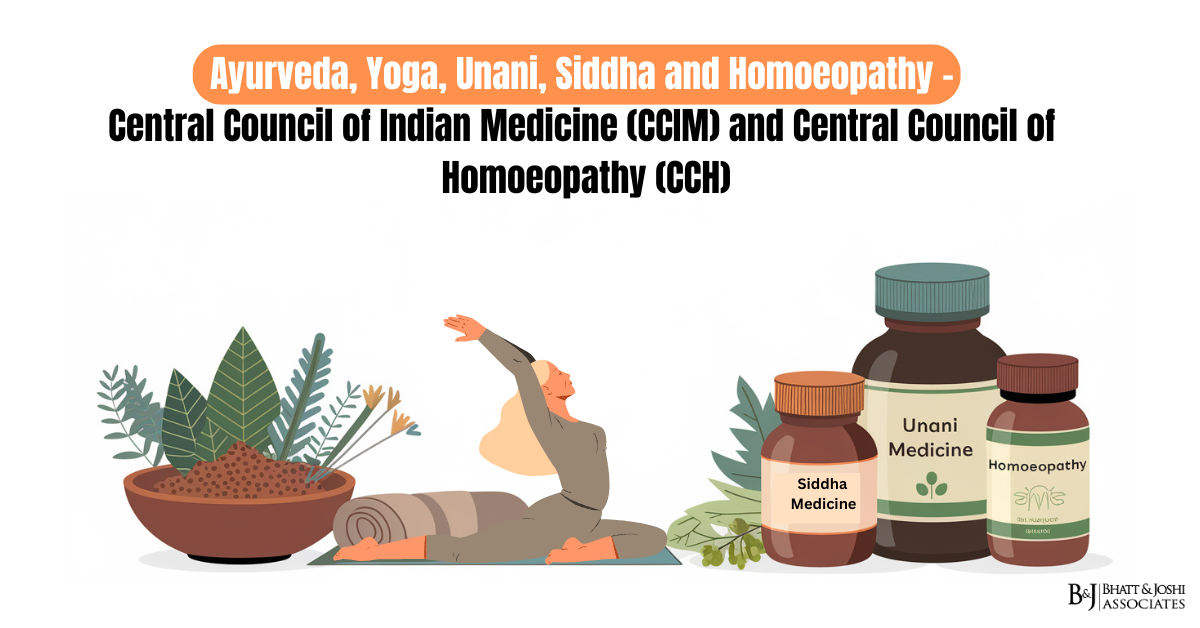Introduction
India’s rich heritage of traditional medicine systems forms an integral part of its healthcare landscape. The regulation of Ayurveda, Yoga, Unani, Siddha, and Homoeopathy (collectively known as AYUSH) is primarily overseen by two statutory bodies: the Central Council of Indian Medicine (CCIM) and the Central Council of Homoeopathy (CCH). These councils operate under the Ministry of AYUSH, Government of India, and play a crucial role in preserving, promoting, and regulating these ancient healing traditions while ensuring their integration into the modern healthcare system.
Historical Context and Evolution of AYUSH
The journey of regulating traditional medicine in India is as old as the systems themselves, with each having its own historical methods of ensuring quality and standards. However, the modern regulatory framework for these systems began to take shape in the post-independence era.
In the years following India’s independence, there was a growing recognition of the need to preserve and promote traditional medicine systems. This led to the establishment of the Central Council of Indian Medicine (CCIM) in 1971 under the Indian Medicine Central Council Act, 1970. The CCIM was tasked with regulating the education and practice of Ayurveda, Siddha, and Unani systems of medicine.
Similarly, recognizing the growing popularity and distinct nature of Homoeopathy, the Central Council of Homoeopathy (CCH) was established in 1973 under the Homoeopathy Central Council Act, 1973. This council was given the mandate to regulate homoeopathic education and practice in India.
The regulation of Yoga and Naturopathy has a slightly different trajectory. While these systems are part of the AYUSH framework, they do not have a separate statutory regulatory body. Instead, their regulation is overseen by the Ministry of AYUSH in conjunction with various governmental and non-governmental organizations.
A significant milestone in the evolution of AYUSH regulation was the establishment of the Department of Indian Systems of Medicine and Homoeopathy (ISM&H) in 1995, which was later renamed as the Department of AYUSH in 2003. This department was elevated to the status of a full-fledged ministry in 2014, marking the government’s commitment to the promotion and development of traditional medicine systems.
Organizational Structure and Functions
The Central Council of Indian Medicine (CCIM) and the Central Council of Homoeopathy (CCH) have similar organizational structures, reflecting their parallel roles in regulating different systems of traditional medicine.
The CCIM consists of members elected from among practitioners of Ayurveda, Siddha, and Unani medicine, as well as representatives from each state and union territory. It also includes members nominated by the central government, representing various stakeholders in the field of traditional medicine.
Similarly, the CCH comprises elected members from among registered homoeopathic practitioners, representatives from state boards, and nominees of the central government. Both councils have a President and Vice-President elected from among their members.
The primary functions of these councils include:
- Prescribing minimum standards of education in AYUSH systems: This involves setting curricula, determining the duration of courses, and specifying the skills and knowledge to be imparted to students.
- Recognizing qualifications: The councils are responsible for recognizing medical qualifications granted by universities or medical institutions in India.
- Registering practitioners: They maintain a Central Register of practitioners in their respective systems of medicine.
- Regulating professional conduct: The councils lay down and enforce standards of professional conduct and etiquette for practitioners.
- Advising the government: They provide recommendations to the central government on matters relating to the recognition of medical qualifications and the regulation of these traditional medicine systems.
Legislative Framework of AYUSH
The regulatory framework for AYUSH systems is primarily based on two key legislations:
- The Indian Medicine Central Council Act, 1970: This Act provides for the constitution of the Central Council of Indian Medicine and the maintenance of a Central Register of Indian Medicine. It outlines the structure, functions, and powers of the CCIM.
- The Homoeopathy Central Council Act, 1973: This Act establishes the Central Council of Homoeopathy and provides for the regulation of homoeopathic education and practice in India.
These Acts have been amended several times over the years to address emerging challenges and to strengthen the regulatory framework. For instance, the Indian Medicine Central Council (Amendment) Act, 2020, and the Homoeopathy Central Council (Amendment) Act, 2020, were passed to oversee the functioning of the respective councils and to ensure transparency and accountability in their operations.
In addition to these primary legislations, several other laws and regulations impact the AYUSH sector:
- The Drugs and Cosmetics Act, 1940, and Rules 1945 (as amended): These provide for the regulation of AYUSH drugs, including their manufacture, sale, and distribution.
- The Medicinal and Toilet Preparations (Excise Duties) Act, 1955: This Act deals with the levy and collection of duties of excise on medicinal and toilet preparations containing alcohol, opium, Indian hemp, or other narcotic drugs.
- Biological Diversity Act, 2002: This Act is relevant to the AYUSH sector as it regulates access to biological resources, which form the basis of many traditional medicines.
- The Scheduled Tribes and Other Traditional Forest Dwellers (Recognition of Forest Rights) Act, 2006: This Act has implications for the sourcing of medicinal plants used in traditional medicine systems.
Key Regulatory Processes and Mechanisms
The CCIM and CCH employ various regulatory processes and mechanisms to fulfill their mandates:
- Curriculum Development: The councils regularly update and revise the curricula for AYUSH education to ensure they remain relevant and incorporate the latest developments in the field. This process involves consultation with experts, practitioners, and academicians.
- Accreditation of Educational Institutions: Both CCIM and CCH are responsible for assessing and accrediting institutions offering courses in their respective systems of medicine. This involves regular inspections and evaluations of infrastructure, faculty, and teaching methods.
- Standardization of Pharmacopoeias: The councils work in collaboration with the Pharmacopoeia Commission for Indian Medicine & Homoeopathy (PCIM&H) to develop and update pharmacopoeias for AYUSH medicines. This is crucial for ensuring the quality and standardization of traditional medicines.
- Research Promotion: While not directly involved in research, the councils play a role in promoting and guiding research in AYUSH systems. They collaborate with research institutions and provide inputs on research priorities.
- Continuing Medical Education: The councils organize and accredit continuing education programs for registered practitioners to ensure they stay updated with the latest developments in their fields.
- Ethics and Disciplinary Mechanisms: Both CCIM and CCH have mechanisms in place to address ethical issues and professional misconduct among practitioners.
Recent Regulatory Developments and Initiatives
The AYUSH sector has seen several significant developments in recent years:
- National Commission for Indian System of Medicine (NCISM) Act, 2020: This Act aims to replace the CCIM with a new commission, similar to the National Medical Commission for allopathic medicine. The NCISM is expected to bring about comprehensive reforms in the regulation of education and practice of Indian systems of medicine.
- National Commission for Homoeopathy (NCH) Act, 2020: Similarly, this Act replaces the CCH with a new commission for homoeopathy. These new commissions are intended to ensure transparency, accountability, and quality in AYUSH education and practice.
- Integration with Modern Medicine: There have been efforts to integrate AYUSH systems with modern medicine, particularly in primary healthcare. The National Medical Commission (NMC) has proposed modules on AYUSH systems for MBBS students, indicating a move towards a more integrated approach to healthcare.
- AYUSH Grid Project: This initiative aims to digitize the AYUSH sector, creating a comprehensive IT backbone for all AYUSH systems. This includes digitizing health records, creating a central repository of AYUSH knowledge, and facilitating telemedicine in AYUSH.
- Traditional Knowledge Digital Library (TKDL): This database documents traditional knowledge related to medicinal plants and formulations used in Indian systems of medicine. It serves as a tool to prevent misappropriation of traditional knowledge through wrongful patents.
- Good Manufacturing Practices (GMP) for AYUSH Products: The Ministry of AYUSH has been working on enhancing the quality standards for AYUSH products through the implementation of Good Manufacturing Practices.
Challenges and Controversies of AYUSH System
The regulation of AYUSH systems faces several challenges and has been subject to various controversies:
- Standardization and Quality Control: One of the biggest challenges is ensuring standardization and quality control of AYUSH medicines. The complexity and diversity of formulations, along with the use of natural ingredients, make this particularly challenging.
- Evidence-Based Practice: There is ongoing debate about the need for evidence-based practices in AYUSH systems. While traditional knowledge is valued, there is increasing pressure to validate the efficacy of treatments through modern scientific methods.
- Integration with Modern Medicine: The integration of AYUSH systems with modern medicine has been a contentious issue. While proponents argue for a holistic approach to healthcare, critics raise concerns about the scientific validity of some AYUSH practices.
- Regulation of Practitioners: Ensuring that all AYUSH practitioners are properly qualified and registered remains a challenge, particularly in rural areas where traditional healers may practice without formal qualifications.
- Intellectual Property Rights: The protection of traditional knowledge and prevention of biopiracy is an ongoing concern. The Biodiversity Act and initiatives like TKDL aim to address this, but challenges remain.
- Cross-System Practice: The issue of AYUSH practitioners prescribing allopathic medicines and vice versa has been a subject of legal and ethical debates. The landmark case of Dr. Mukhtiar Chand & Ors. vs. State of Punjab & Ors. (1998) addressed this issue, but controversies persist.
International Collaborations and Global Standing
The regulation and promotion of AYUSH systems have significant international dimensions:
- WHO Collaborations: India has been working closely with the World Health Organization (WHO) to develop benchmarks for training in Ayurveda, Yoga, and Unani. The WHO Global Centre for Traditional Medicine, set up in Gujarat, India, is a significant step towards global recognition of traditional medicine systems.
- International Cooperation: The Ministry of AYUSH has signed Memorandums of Understanding (MoUs) with several countries for cooperation in traditional medicine. These agreements often include provisions for mutual recognition of qualifications and exchange of expertise.
- AYUSH Mark: The government has introduced the AYUSH Premium Mark to certify quality AYUSH products for the international market, aiming to enhance the global acceptance of Indian traditional medicines.
- Yoga Diplomacy: The international promotion of Yoga, including the establishment of International Yoga Day, has significantly enhanced the global profile of Indian traditional wellness practices.
- Research Collaborations: There are increasing collaborations between Indian AYUSH institutions and international research organizations to conduct scientific studies on traditional medicines and practices.
Future Directions and Challenges
As AYUSH systems continue to gain prominence both nationally and internationally, several key areas will shape their future regulation and development:
- Integration of Traditional and Modern Systems: The challenge lies in finding a balanced approach that respects the fundamental principles of AYUSH systems while leveraging modern scientific methods for validation and research.
- Digitalization and Telemedicine: The AYUSH Grid and other digital initiatives are likely to play a crucial role in expanding the reach of AYUSH systems, particularly in remote areas.
- Sustainable Sourcing of Medicinal Plants: As demand for AYUSH products grows, ensuring sustainable sourcing of medicinal plants will be crucial. This involves conservation efforts and promoting cultivation of medicinal plants.
- Global Recognition and Standardization: Efforts towards gaining global recognition for AYUSH qualifications and practices are likely to intensify. This may involve further alignment with international standards and practices.
- Research and Development: Enhancing research capabilities in AYUSH systems, including conducting large-scale clinical trials and publishing in reputed international journals, will be key to their wider acceptance.
- Addressing Regulatory Gaps: The transition to the new regulatory bodies (NCISM and NCH) will need to address existing regulatory gaps and enhance the overall governance of AYUSH systems.
- Capacity Building: There will be a continued focus on improving the quality of AYUSH education and enhancing the skills of practitioners to meet evolving healthcare needs.
Conclusion: The Future of AYUSH Regulation and Its Impact
The regulation of Ayurveda, Yoga, Unani, Siddha, and Homoeopathy in India represents a unique blend of preserving ancient wisdom while adapting to modern healthcare demands. The Central Council of Indian Medicine and the Central Council of Homoeopathy, along with their successor bodies, play a crucial role in this complex landscape.
As India continues to position itself as a global leader in traditional medicine, the regulatory framework for AYUSH systems will need to evolve to meet both domestic healthcare needs and international standards. The challenges are significant – from ensuring quality and efficacy to integrating with modern medical practices – but so are the opportunities.
The future of AYUSH regulation in India will likely see a continued emphasis on scientific validation, quality control, and global integration, while staying true to the fundamental principles of these traditional systems. As these ancient healing traditions meet modern regulatory standards and scientific scrutiny, they have the potential to contribute significantly to global healthcare solutions.
The journey of AYUSH regulation in India is more than just a regulatory exercise; it’s a reflection of India’s efforts to harness its rich cultural heritage to meet contemporary health challenges. As these systems continue to evolve and gain recognition, their regulation will play a crucial role in shaping the future of healthcare not just in India, but potentially around the world.














